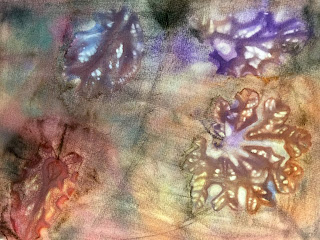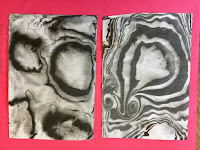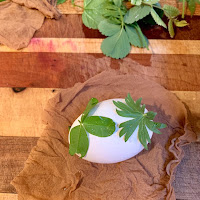
Happen Halloween
 “The Son of a Man” by Rene Magritte #artteacherlife #imademycostume
“The Son of a Man” by Rene Magritte #artteacherlife #imademycostumeTK and Kindergarten: Leaf Prints
TK and Kindergarten students were introduction to printing with leaves. TK students made ghost leaf prints and Kindergarten students worked on watercolor printing. Students were taught the wet-on-wet watercolor technique - using a water wash on the paper, on which a color is applied while the paper is still wet.
The myriad patterns and textures found on fall leaves, which were collected around campus were transferred by placing wet leaves onto a yellow underpainting. Students painted on top of the leaves with a variety of colors. Leaves must stay on background until completely dry! The result - soft backgrounds contrasted with beautiful textured patterns from nature!
1st Grade: Drawing Basics: Light and Shadows
Light and shadows visually define objects. First grade students were introduced to the concept of light and shadows and trained their eyes to see like an artist. First grade students studied a still-life model with a light source (lamp) illuminating objects.
Students observed the following: A shadow is made when an object blocks light. The object must be opaque or translucent to make a shadow. A transparent object will not make any shadow, as light will pass straight through it. The Sun is a very bright natural light source. It seems to move across the sky during the day. In fact, it just looks like it does that because the Earth is spinning.The Sun casts (makes) the longest shadows at the beginning and end of the day, when the Sun is lowest in the sky. The Sun casts the shortest shadows at midday, when the Sun is highest in the sky.
Students practiced shading techniques and applied form and cast shadows to geometric forms. Students also drew a fruit still-life and defined the objects applying the concepts of light and shadows.
1st grade students are able to visually identify the following:
- Light source: The direction from which a dominant light originates. The placement of this light source affects every aspect of a drawing.
- Form Shadows: The areas on an object (form), a range of values that receive little or no light.
- Cast shadow: The dark area on an adjacent surface where the light is blocked by the solid object
2nd GRADE: Color Theory, Color Wheel
Second grade students were introduced to the basics of color theory. Students were fascinated by the connection of art and science and how all the colors in the color wheel can be mixed by using just the three primary colors. Students had the opportunity to mix their very own color wheels using only red, yellow and blue.
Following the color wheel lesson, 2nd grade students were introduced to tints. In color theory, a tint is the mixture of a color with white, which increases lightness, and a shade is the mixture of a color with black, which reduces lightness.
A tint is created when you add white to a color and lighten it. It is also sometimes called a pastel color. Tints can range from nearly the full saturation of the hue to practically white. Sometimes artists add a small bit of white to a color to increase its opacity and covering strength.
Tinting a color also desaturates the hue, making it less intense. Red when tinted becomes pink. Blue when tinted becomes "baby blue." Tints, or pastels, are often thought of as calmer and quieter colors, and are often used for newborn apparel and accessories.
Knowing how to use tint, tone, and shade in painting will help express space, depth, and form and better communicate ideas.
Students picked a primary, or secondary color as the main hue to paint hills of a landscape. Using white in addition to the main hue, students learned to mix tints, from dark to light to create a sense of space to depict a hilly landscape.
3rd and 4th grade: The Art of Suminagashi
3rd and 4th grade students were introduced to the art of Suminagashi. Suminagashi is the ancient Japanese technique of painting on water to create marbleized effects on paper. Literally, it means “ink-floating”, which is in reference to the Sumi-e inks that were originally used in the technique. It is an ancient Japanese Marbling Art technique. Suminagashi (墨 流 し) originated in Japan as early as the 12th century. Marbling is a method of decorating paper or fabric to imitate marble and other stone where color is suspended in a thickened liquid and manipulated into various patterns.
Students were fascinated by the science behind this marbling technique. They learned that the surface tension of the water (a thin membrane formed by molecules) allows the ink to float on top as long as the artist is not penetrating the membrane with the ink brush. A solution of water and dish soap is carefully placed on the surface of the water bath to repel and resist the ink. Surface tension becomes visible with Suminagashi!
Students worked with a partner taking turns carefully applying the ink and soap water solution with brushes on the water surface. Lots of spontaneous "oohhhs" and "ahhhs" could be heard around the art room as students created delicate, marbled designs.
In order to capture the process and technique of this fascinating art form students recorded short videos to share with their families via the Seesaw app.

































